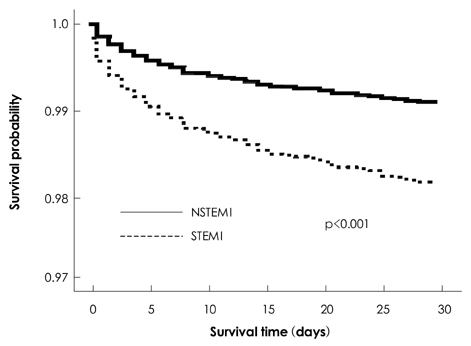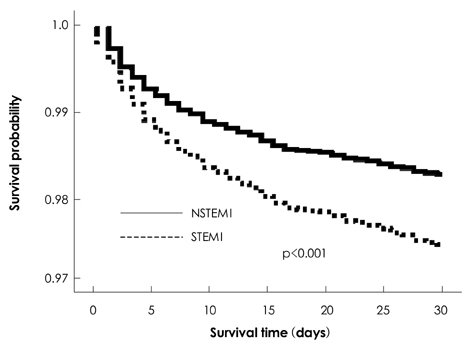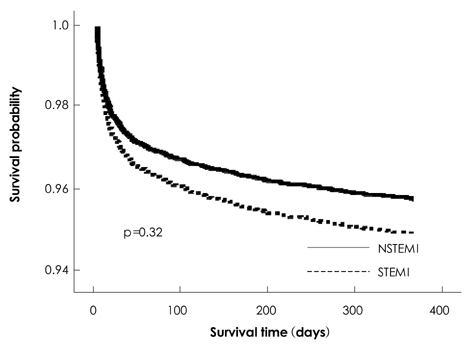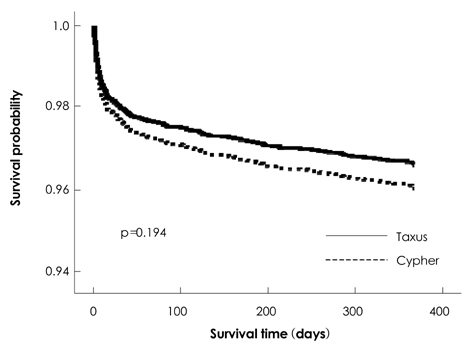Korean Circ J.
2009 Aug;39(8):297-303. 10.4070/kcj.2009.39.8.297.
Differences in Clinical Outcomes Between Patients With ST-Elevation Versus Non-ST-Elevation Acute Myocardial Infarction in Korea
- Affiliations
-
- 1The Heart Research Center of Chonnam National University Hospital, Gwangju, Korea. myungho@chollian.net
- KMID: 2225678
- DOI: http://doi.org/10.4070/kcj.2009.39.8.297
Abstract
- In Korea, the incidence of acute myocardial infarction has been increasing rapidly. Twelve-month clinical outcomes for 13,133 patients with acute myocardial infarction enrolled in the nationwide prospective Korea Acute Myocardial Infarction Registry study were analyzed according to the presence or absence of ST-segment elevation. Patients with ST-segment elevation myocardial infarction (STEMI) were younger, more likely to be men and smokers, and had poorer left ventricular function with a higher incidence of cardiac death compared to patients with non-ST-segment elevation myocardial infarction (NSTEMI). NSTEMI patients had a higher prevalence of 3-vessel and left main coronary artery disease with complex lesions, and were more likely to have co-morbidities. The in-hospital and 1-month survival rates were higher in NSTEMI patients than in STEMI patients. However, 12-month survival rates was not different between the two groups. In conclusion, NSTEMI patients have worse clinical outcomes than STEMI patients, and therefore should be treated more intensively during clinical follow-up.
MeSH Terms
Figure
Cited by 2 articles
-
Development of Smartphone Educational Application for Patients with Coronary Artery Disease
Min Jung Cho, Jae Lan Sim, Seon Young Hwang
Healthc Inform Res. 2014;20(2):117-124. doi: 10.4258/hir.2014.20.2.117.Continuous Abstinence Rates from Smoking Over 12 Months according to the Frequency of Participation in a Hospital-based Smoking Cessation Program among Patients Discharged after Acute Myocardial Infarction
Young-Hoon Lee, Mi-Hee Han, Mi Rim Lee, Jin-Won Jeong, Nam-Ho Kim, Seok Kyu Oh, Kyeong Ho Yun, Sang Jae Rhee, Jum Suk Ko, Gyung-Jae Oh
Korean J Health Promot. 2016;16(1):48-55. doi: 10.15384/kjhp.2016.16.1.48.
Reference
-
1. Lee SR, Jeong MH, Ahn YK, et al. Clinical safety of drug-eluting stents in the Korea acute myocardial infarction registry. Circ J. 2008. 72:392–398.2. Song YB, Hahn JY, Gwon HC, Kim JH, Lee SH, Jeong MH. The impact of initial treatment delay using primary angioplasty on mortality among patients with acute myocardial infarction: from the Korea acute myocardial infarction registry. J Korean Med Sci. 2008. 23:357–364.3. Jeong HC, Ahn YK, Jeong MH, et al. Intensive pharmacologic treatment in patients with acute non ST-segment elevation myocardial infarction who did not undergo percutaneous coronary intervention. Circ J. 2008. 72:1403–1409.4. Lee SH, Kim YJ, Kim W, et al. Clinical outcomes and therapeutic strategy in patients with acute myocardial infarction according to renal function: data from the Korean Acute Myocardial Infarction Registry. Circ J. 2008. 72:1410–1418.5. Lee SH, Park JS, Kim W, et al. Impact of body mass index and waist-to-hip ratio on clinical outcomes in patients with ST-segment elevation acute myocardial infarction (from the Korean Acute Myocardial Infarction Registry). Am J Cardiol. 2008. 102:957–965.6. Lee KH, Jeong MH, Ahn YK, et al. Gender differences of success rate of percutaneous coronary intervention and short term cardiac events in Korea Acute Myocardial Infarction Registry. Int J Cardiol. 2008. 130:227–234.7. Kwon TG, Bae JH, Jeong MH, et al. N-terminal pro-B-type natriuretic peptide is associated with adverse short-term clinical outcomes in patients with acute ST-elevation myocardial infarction underwent primary percutaneous coronary intervention. Int J Cardiol. 2009. 133:173–178.8. Lee JH, Chae SC, Yang DH, et al. Influence of weather on daily hospital admissions for acute myocardial infarction (from the Korea Acute Myocardial Infarction Registry). Int J Cardiol. 2009. [Epub ahead of print].9. Lee JH, Park HS, Chae SC, et al. Predictors of six-month Major adverse cardiac events in 30-day survivors after acute myocardial infarction (from the Korea Acute Myocardial Infarction Registry). Am J Cardiol. 2009. 104:182–189.10. Chen KY, Rha SW, Li YJ, et al. Triple versus dual anti-platelet therapy in patients with acute ST-segment elevation myocardial infarction undergoing primary percutaneous coronary intervention. Circulation. 2009. 119:3168–3170.11. Sim DS, Jeong MH, Ahn YK, et al. Safety and benefit of early elective percutaneous coronary intervention after successful thrombolytic therapy for acute myocardial infarction. Am J Cardiol. 2009. 103:1333–1338.12. Cho JY, Jeong MH, Ahn YK, et al. Predictive factors of major adverse cardiac events and clinical outcomes of acute myocardial infarction in young Korean patients. Korean Circ J. 2008. 38:161–169.13. Lee MG, Jeong MH, Ahn YK, et al. Comparison of clinical outcomes in hypertensive patients with acute myocardial infarction according to the presence of diabetes. Korean Circ J. 2009. 39:243–250.
- Full Text Links
- Actions
-
Cited
- CITED
-
- Close
- Share
- Similar articles
-
- ST segment
- A Case of Acute Myopericarditis with Localized ST Elevation Mimicking Myocardial Infarction
- Acute Myocardial Infarction by Right Coronary Artery Occlusion Presenting as Precordial ST Elevation on Electrocardiography
- Coronary Slow Flow Phenomenon Leads to ST Elevation Myocardial Infarction
- A Case of ST-Segment Elevation in a Patient with Subarachnoid Hemorrhage





